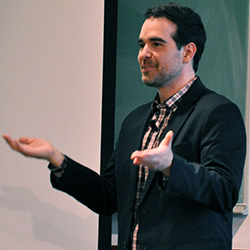Dario Robleto Discusses Recorded Heartbeats
Robleto’s visit was a part of Northwestern Engineering’s Dean Seminar Series on May 9
When Voyager 1 launched in 1977, the space probe carried a gold phonograph record containing sounds and images that represented life on Earth. Scientists, including famed astrophysicist Carl Sagan, intended for potential intelligent life beyond our solar system to play the “Golden Record” upon finding it in the distant future.
In 1982, Dario Robleto was 10 years old and first heard about the Golden Record during a news report. Home sick from school, he mistakenly believed that the record contained the first known sounds of extraterrestrial life. When he dialed a mysterious 1-800 number to hear the sounds, he was disappointed to hear not alien gibberish but a fuzzy, accelerated recording of a human heartbeat.
 “I cannot describe how disappointed I was,” Robleto said. “That disappointment led me to be an artist. Sound with time and distance is the most beautiful thing I ever heard.”
“I cannot describe how disappointed I was,” Robleto said. “That disappointment led me to be an artist. Sound with time and distance is the most beautiful thing I ever heard.”
A part of the Northwestern Engineering’s Dean’s Seminar Series, Robleto discussed how this experience led him down a long path to unearth the first recorded sounds of a human heartbeat, a feat that has shaped his career. Co-sponsored by the Mary and Leigh Block Museum of Art, the seminar took place Tuesday, May 9 in the Ford Motor Company Engineering Design Center.
The Golden Record contained two hours of sounds, including the recorded heartbeat and brainwaves of Ann Druyan, the creative director of NASA’s interstellar message project. While working on the project, Druyan and Sagan fell in love and later married. Hooked up to an EKG and EEG, Druyan’s heartbeat and brainwaves were recorded for one hour, during which she partly thought about her love for Sagan and imagined their future together. The pair wondered if future humans or intelligent life beyond Earth might someday be able to decipher the sounds of her heartbeat and brainwaves to determine what Druyan was thinking and feeling at the time.
“If we take Ann at her word, we have to know that love is in there and is decipherable,” Robleto said. “When I first heard the recording, I didn’t realize that I was hearing a human trying to preserve love.”
Inspired by Druyan’s recordings, Robleto wondered when the first human heartbeat was recorded and why. He started his journey by studying the “Talking Machine,” invented by Thomas Edison in 1877. Later called the phonograph, the device could record and play back sound. Robleto, however, sensed that earlier recordings existed.
“Can we go back further?” he asked. “How far back in time can we go to access the memory of human hearts?”
Delving further into history, Robleto next found Édouard-Léon Scott de Martinville’s phonautograph. Invented in 1857, the phonautograph captured sound vibrations but could not play them back. In 2008, scientists converted an 1860 recording from “squiggles on paper” to an audio file. In part of the recording, a person sings the French folk song “Au Clair de la Lune.”
Continuing the backwards search, Robleto and media historian Patrick Feaster discovered a photographic chart created in 1869 by French physician Charles Ozanam. Called a photosphysmograph, the chart depicted the heartbeat of Monsieur Léger, a 100-year-old man who served in the French military and helped storm the Bastille during the French Revolution. The chart displayed the amplitude of Léger’s heartbeat as it changed over time, which Feaster converted into sound.
“They look like forgotten ocean waves,” Robleto said. “But it’s the beating of a heart.”
Considering that Léger was born in 1769, his heartbeat could be the earliest one ever recorded. But Robleto is not ready to stop searching. He believes that scientists could eventually uncover sounds accidentally captured in clay pots, from markings of dinosaur tails sweeping through the mud, or from ancient earthquakes shaking through stone.
“I’m curious to keep going further back,” he said. “I really want to know how much further back we can go with sound.”